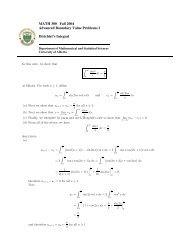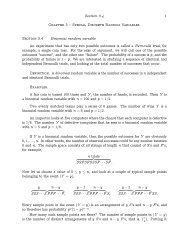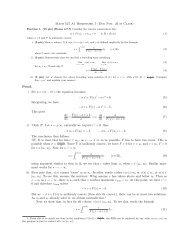Math 411: Honours Complex Variables - University of Alberta
Math 411: Honours Complex Variables - University of Alberta
Math 411: Honours Complex Variables - University of Alberta
Create successful ePaper yourself
Turn your PDF publications into a flip-book with our unique Google optimized e-Paper software.
90CHAPTER13. FUNCTIONTHEORETICCONSEQUENCESOFTHERESIDUETHEOREM<br />
Pro<strong>of</strong>. It is easily checked that the meromorphic functions do indeed form a commutative<br />
ring. For each meromorphic function f �≡ 0 on D define<br />
˜f: D → C, z ↦→ 1<br />
f(z) .<br />
AsP(f)isdiscrete, D\P(f)isconnectedbyLemma13.1. FromtheIdentityTheorem,<br />
we then conclude that Z(f) is discrete, too. Thus ˜ f is meromorphic and (f ˜ f)(z) = 1<br />
(the multiplicative identity) for z ∈ D.<br />
Definition. Let z0 ∈ Z(f). If f(z) = (z−z0) k g(z), where g is a holomorphic function<br />
with g(z0) �= 0, we say that k := ord(f,z0).<br />
Theorem 13.2 (Argument Principle). Let D ⊂ C be open and simply connected, let<br />
f be meromorphic on D, and let γ be a closed curve in D \(P(f)∪Z(f)). Then we<br />
have �<br />
1<br />
2πi<br />
γ<br />
f ′ (ζ) �<br />
dζ = ν(γ,z)ord(f,z)−<br />
f(ζ)<br />
z∈Z(f)<br />
�<br />
ν(γ,z)ord(f,z).<br />
z∈P(f)<br />
Pro<strong>of</strong>. By the Residue Theorem, we have<br />
�<br />
1 f<br />
2πi γ<br />
′ (ζ) �<br />
� ′ f<br />
dζ = ν(γ,z) res<br />
f(ζ) f<br />
z∈Z(f)<br />
,z<br />
�<br />
+ �<br />
z∈P(f)<br />
� ′ f<br />
ν(γ,z) res<br />
f ,z<br />
�<br />
.<br />
Let z0 ∈ Z(f), and let k := ord(f,z). Then there is a holomorphic function g<br />
with g(z0) �= 0 such that f(z) = (z −z0) k g(z) and thus<br />
It follows that<br />
for z near z0, so that<br />
f ′ (z) = k(z −z0) k−1 g(z)+(z −z0) k g ′ (z).<br />
f ′ (z)<br />
f(z)<br />
k<br />
= +<br />
z −z0<br />
g′ (z)<br />
g(z)<br />
� ′ f<br />
res<br />
f ,z<br />
�<br />
= k.<br />
Let z0 ∈ P(f), and let k := ord(f,z0). Then f(z) =<br />
holomorphic such that g(z0) �= 0 and, consequently,<br />
It follows that<br />
for z �= z0 near z0, so that<br />
f ′ (z) = −k(z −z0) −(k+1) g(z)+(z −z0) −k g ′ (z).<br />
f ′ (z)<br />
f(z)<br />
−k<br />
= +<br />
z −z0<br />
g′ (z)<br />
g(z)<br />
� ′ f<br />
res<br />
f ,z<br />
�<br />
= −k.<br />
g(z)<br />
holds with g<br />
(z −z0) k







